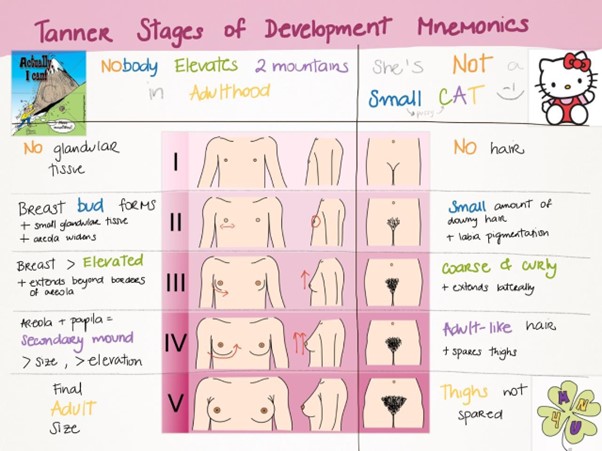Which is assessed with Tanner staging?
Growth hormone secretion
Hormone levels
Hyperthyroidism
Secondary sex characteristic
The Correct Answer is D
Tanner staging is a method used to assess and describe the development of secondary sex characteristics during puberty. It is primarily focused on the physical changes that occur as individuals transition from childhood to adulthood. The Tanner scale consists of different stages (I to V) that describe the development of specific secondarysex characteristics such as breast development, pubic hair growth, genital development, and facial hair growth.
Growth hormone secretion in (option A) is incorrect because While growth hormone does play a role in the overall growth and development of individuals during puberty, Tanner staging does not specifically measure or assessgrowth hormone secretion.
Hormone levels in (option B) is incorrect because While hormone levels, including sex hormones such as estrogenand testosterone, do play a significant role in the development of secondary sex characteristics, Tanner staging itself does not involve measuring or assessing hormone levels. Hormone levels can be assessed through laboratory testing, but this is a separate process from Tanner staging
Hyperthyroidism in (option C) is incorrect because Hyperthyroidism, on the other hand, is a medical condition characterized by an overactive thyroid gland that produces an excessive number of thyroidhormones. It is not directly related to the development of secondary sex characteristics. Diagnosing hyperthyroidism typically involves assessing symptoms, conducting physicalexaminations, and performing specific blood tests to measure thyroid hormone levels and evaluate thyroidfunction.

Nursing Test Bank
Naxlex Comprehensive Predictor Exams
Related Questions
Correct Answer is A
Explanation
The nurse's best response to the student nurse regarding why peer relationships become more important during adolescence is option A. Peer relationships become significant during adolescence because they provide adolescents with a sense of belonging. During this developmental stage, adolescents are transitioning from a primary focus on their family to a greater emphasis on peer interactions and social connections. Peer relationships offer a sense of acceptance, support, and identity as adolescents strive to establish their own identities separate from their families.
adolescents dislike their parents in (option B), is not a correct or comprehensive explanation for the increased importance of peer relationships during adolescence. While it is common for parent-child conflicts to arise during this stage, it does not imply that adolescents dislike their parents as a general rule.
suggesting that adolescents no longer need parental control in (option C), is not correct. While adolescents are seeking increased independence and autonomy, they still require parental guidance and support. Parental control and involvement continue to be essential in providing a secure and nurturing environment during adolescence.
They promote a sense of individuality in adolescents in (option D), is incorrect. Peer relationships do contribute to the development of individuality by allowing adolescents to explore their own interests, values, and social roles. However, the primary reason for the increased importance of peer relationships during adolescence is the sense of belonging and social acceptance they provide.
Correct Answer is D
Explanation
The first sign of pubertal change seen with boys is testicular enlargement. This is known as testicular or scrotal growth and is one of the earliest physical signs of puberty in boys. Testicular enlargement is followed by other changes such as the growth of pubic hair, penile growth, voice deepening, and facial hair growth.
voice deepening in (option A) is incorrect because it, typically occurs after testicular enlargement and is associated with the growth and development of the larynx during puberty.
scrotal enlargement in (option B) is incorrect because it, may occur simultaneously or shortly after testicular enlargement as part of overall genital growth during puberty.
, facial hair growth in (option C) is incorrect because it, is a later sign of pubertal development in boys and typically occurs after the initial testicular enlargement and growth of pubic hair.
Whether you are a student looking to ace your exams or a practicing nurse seeking to enhance your expertise , our nursing education contents will empower you with the confidence and competence to make a difference in the lives of patients and become a respected leader in the healthcare field.
Visit Naxlex, invest in your future and unlock endless possibilities with our unparalleled nursing education contents today
Report Wrong Answer on the Current Question
Do you disagree with the answer? If yes, what is your expected answer? Explain.
Kindly be descriptive with the issue you are facing.
